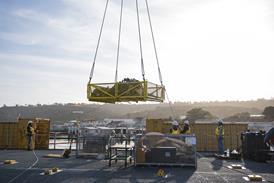
Tim Furniss/LONDON
NASA's Deep Space 1 (DS1) spacecraft is being propelled to its rendezvous with an asteroid by an ion propulsion system, the first use of such a system in the history of interplanetary exploration.
The DS1, which was launched from Cape Canaveral, Florida, on 24 October, is the first of NASA's New Millennium "faster, better, cheaper" technology demonstrators. The New Millennium programme is the brainchild of NASA Administrator Daniel Goldin. Spectrum Astro built the lightweight 365kg spacecraft, which uses a high efficiency, low thrust, xenon ion propulsion system built by Hughes Electron Dynamics. The ion engine will propel the DS1, with the aid of an "artificial intelligence" navigation and guidance system, towards a 15km/s, 10km-distant fly-by of asteroid 1992 KD in July 1999.
The DS1 also carries several other new technologies which will be demonstrated during the pathfinding mission. These include a solar concentrator array and a miniature camera. It is the ion engine, however, that is catching the attention that could make it a primary method of spacecraft propulsion in the 21st century.
An ion engine is 10 times more efficient than a heavier chemical engine - it produces 10 times the specific impulse (the ratio of thrust to propellant used) of a chemical engine, consuming far less propellant. The DS1 was launched with 58kg of xenon on board.
Operating for as much as one year at very low thrust, an ion engine can increase the velocity of a spacecraft on a long interplanetary journey just as effectively as a quick one-off firing of a chemical engine. The DS1 will reach its destination in half the time it would have taken using chemical propulsion.
The demonstrator engine is just 300mm in diameter and generates its thrust by accelerating electrically charged xenon atoms. These positively charged ions are emitted at speeds of 108,800km/h, but produce low thrust - about 0.02lb, compared with a 2,200lb-thrust chemical engine - which is being produced for thousands of hours, enabling the spacecraft to travel long distances at increasing speed. The ion propulsion system will increase the DS1's speed by 12,640km/h during the mission, from a starting velocity of 38,000km/h.
Ion propulsion is also called solar electric propulsion because it depends on electricity generated by solar panels which convert the sun's energy into the required electricity - provided that the craft is close enough to the sun.
Not surprisingly, therefore, another new technology payload is an advanced solar concentrator array system that provides power to the ion engine. Developed with the co-operation of NASA by Able Engineering of California for the US Ballistic Missile Defense Organization, and called the Scarlet II (Solar Concentrator Arrays with Refractive Linear Element Technology), it is the first modular concentrator solar array to be used in space.
The Scarlet II achieves high performance at low cost by replacing 85% of the expensive solar cells on a conventional array with easily produced linear refractive concentrators that focus incoming solar energy on to high efficiency solar cells. The Scarlet II array on the DS1 provides 2.5kW of electrical power, with a power to weight ratio of nearly 50W/kg. This makes it the most weight-efficient solar array ever flown.
Another new technology is the autonomous optical navigation system, which uses images of asteroids and stars, collected by the on-board camera system, to enable the navigation system to compute and correct the craft's course.
Beacon monitoring systems, like that on the DS1, will eventually reduce the need for mission controllers to monitor the health of the spacecraft at all times. The craft's beacon monitor will have the ability to beam one of four signals to earth, summarising its status and indicating the urgency of any need for human intervention.
The autonomous operations system is composed of an "agent" that can plan, make decisions and operate independently. Software allows the spacecraft to think and act without human intervention or guidance. The agent also knows when a failure has occurred, what to do about it and when to call for help.
New, low-mass communications devices include a miniaturised 3.2kg transponder and associated high frequency, solid-state amplifier.
A camera-imaging spectrometer has about 10 times less mass, cost and power consumption than that of conventional instruments. Comparative imaging will be performed using a standard charge-coupled device and a new active pixel sensor, which integrates electronics and detector on a chip. The mass of the miniature ion and electron spectrometer is one-fifth that of conventional instruments and requires about one-third less power.
Source: Flight International























